|
THE LAKE TANKER
THE LAGO REFINERY SUPPLY LINE
|
|
| The Maracay, just one of many Lake Tankers that
ran between Lake Maracaibo and Aruba supplying the Lago refinery with
the crude oil it needed to stay in business. |
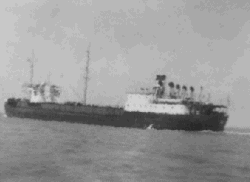 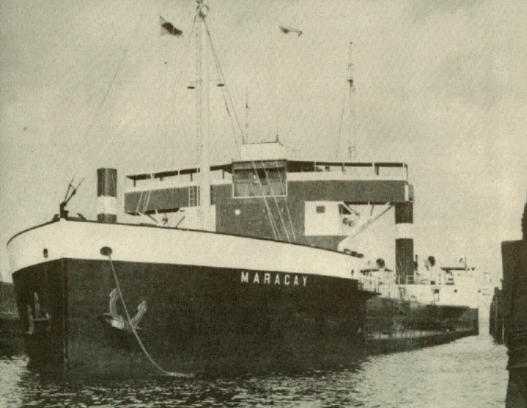
The photograph above is the Esso Trujillo running
empty. The photo to the right is the Esso Maracay loaded, being
tied up to a dock to be ready to be unloaded.
Most
of the officers on the Lake Tankers were from England and many of them
had family who lived in Lago Colony while they sailed back and forth to
Lake Maracaibo. |
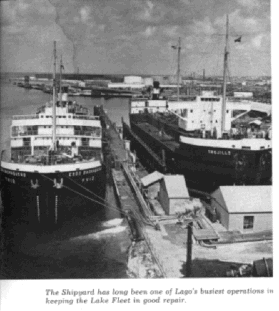
All the maintenance on the Lake Tankers was done at the dry-dock
in Aruba. This photograph shows the Esso Trujillo (right) in
dry-dock. The tanker to the left is tied to the pier next to the
dry-dock but is till in the water. |
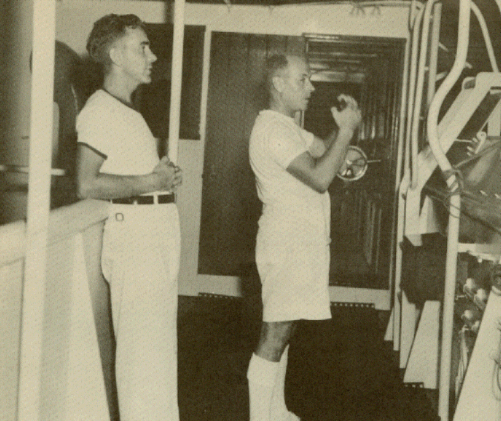 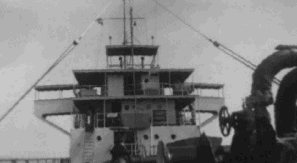
The bridge of the lake tanker, from here the ship is steered and the
mid-ship is where the Captain and Officers live, in quarters under the
bridge. Note the "wings" off each side of the bridge so the person
in charge can walk out and look down each side of the tanker as well as
aft.
The photo to the right shows two officers on the wing of the
bridge. The door goes into the part of the bridge from where the
ship is steered.
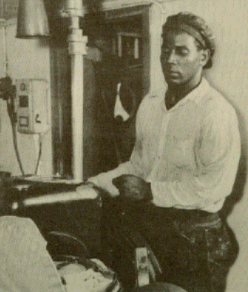
This photo to the left shows a seaman steering the
Lake Tanker. |
|
The Pedernales, one of the early Lake Tankers was
torpedoed on February 16, 1942, the night the
German U-Boat U-156 attack four tankers. Of the four that were
torpedo three of them sank. The Pedernales was torpedo in the
mid-ship and the crew managed to beach the tanker. After she was
pulled from the beach she was taken to the Lago Dry Dock, the mid-ship
section was cut out and the bow and aft end were welded together, a
temporary wheel house (bridge) was added and she was taken to Baltimore
under her own steam and a new mid-ship section (tanks) were installed
and she returned to Aruba and was put back into service. To link
to the story of the U-Boat attack.
(LINK TO U-156) |
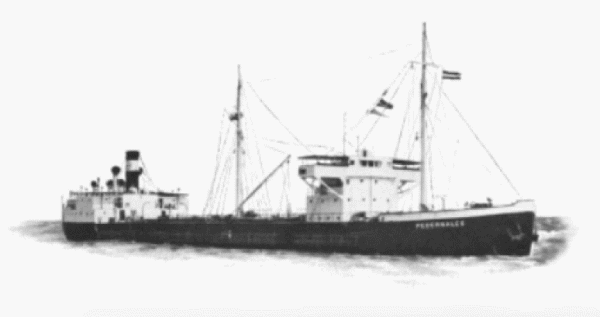
The war years were not kind to the Lake Tankers and a couple were
torpedoed by German U-Boats. The Lake Tanker Pedernales,
shown right, before she was torpedoed.
|
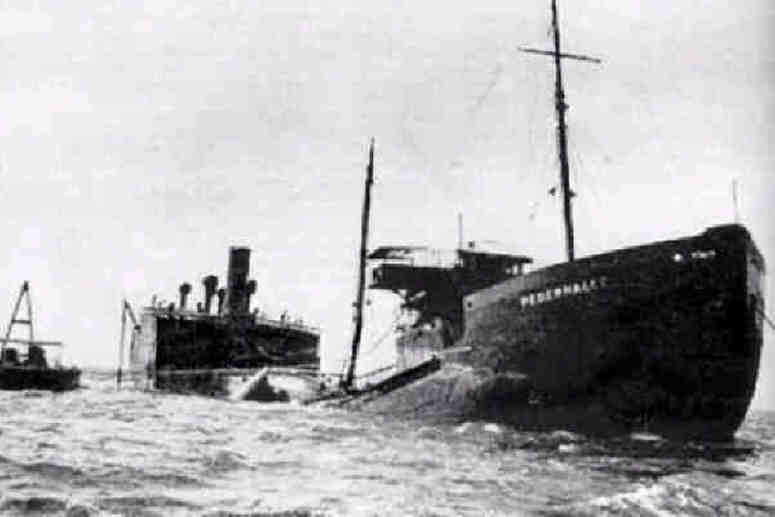
And the Lake Tanker Pedernales,
shown left, after she was torpedoed. |
|
CLICK ON EITHER PHOTO BELOW TO SEE
THE TRIP ON A LAKE TANKER |
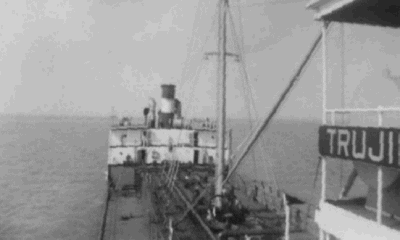 Picture
on the right, a view from the Bridge of the Esso Trujillo looking aft to
the back of the Lake Tanker. Picture
on the right, a view from the Bridge of the Esso Trujillo looking aft to
the back of the Lake Tanker.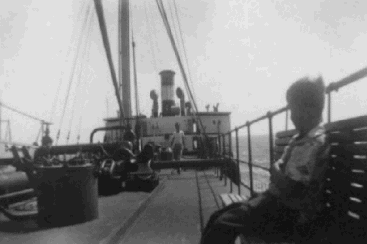
The picture on the left is the deck of the Esso
Trujillo, she is high in the water so must be going back to Make
Maracaibo for a load of crude. |
| THE LAKE TANKER
By
DAN JENSEN
| The entire operation in Aruba depended on a fleet of
little tankers that carried the crude from Lake Maracaibo,
through the shallow cannel to the Caribbean Sea and onto Aruba. |
| The fleet of Lake Tankers were referred to as "The
Mosquito Fleet". Why it was referred to by that name I
have not been able to ascertain. Was it because the buzzed
back and forth between Aruba and Lake Maracaibo like swarms of
mosquitoes, sucking up crude like blood, or was it because of
the mosquitoes they must have encountered while at the lake and
making the passage through the shallow cannel into the lake. |
| The first lake tankers were supplied by and managed by
Andrew Weir and Co. Ltd. of London and the officers and some of
the early crew were men of the English Merchant Marine and most
were Scots. How long the lake tanker fleet ran under the
management of Andrew Weir I have not been able to find out. |
|
he first two lake tankers were the
Francunion and the Inverhampton. The
Inverhampton was lost on a sand bar going into Lake
Maracaibo and showed as a cross on charts of the bar for many
years. |
| You can better understand how a ship of this size was
lost crossing the bar when you read the following account from
someone who had first hand knowledge of the trip. This
description of crossing the bar in the early years, before
dredging had begun, is by Captain F. C. Alexander and I found it
on Auke Visser's web site, Other Esso related Companies. |
|
"The Fairway Buoy to the seaward side of
the bar was the only lighted one. When a master got his
ship to its vicinity in the small hours of the morning, he
usually had to maneuver around, invariable in a N.E. gale with a
heavy sea running and with his ship in ballast, waiting for the
first glimmer of dawn and sight of the leading mark poles set up
on the sandy shore to guide him over the outer bar. It was
a weird and nerve-wracking experience going over the outer bar
at the break of dawn until one got used to it. With a
heavy following sea in the shallow water the breakers stretched
for miles, and were as high sometimes as the rollers in a
Western Ocean gale. In going over the bar it was nothing
less than full speed, heading for the beach with a heavy surf
just a matter of four or five hundred yards away and trying to
hold the ship on mark. If the master got off the mark, he
"had it"." |
|
"With a depth of water of only about 12
feet, in a heavy sea, the bumps were frequent and pooping was
not uncommon, (For you landlubbers, pooping is a nautical
term, that mean: To take seas over the stern of the ship) On
a rough morning it was not infrequent for most of the crew to be
on deck and I can remember one morning when we pooped a
big sea to hear wild yells from aft and glimpsed an avalanche of
water coming through the port and starboard alleyways aft in
which were submerged, men, dogs, deck chairs, pots and pans and
ship's gear." |
| "A right angle turn to the east was made just before
the ship hit the beach, which brought her into the buoyed
channel, where one had to contend with traffic rolling and
abnormal leeway with a weather beach just a ship's length away." |
| "A right angle turn to the east was made just before
the ship hit the beach, which brought her into the buoyed
channel, where one had to contend with traffic rolling and
abnormal leeway with a weather beach just a ship's length away." |
| "Coming out with a loaded ship was a nightmare, for
the maximum loaded draft then was 9 feet. Never were tide
tables studied so carefully or height of tide problems so
studiously worked out to the inch. It was usual to allow
for 18 inches under the keel, an extra inch in draft represented
a few more barrels of oil out of the lake, and this despite the
fact that heavy seas might be encountered going out over the
outer bar. The vessels just bumped their way out with
never any apparent bottom damage." |
| "If a ship ran ashore, the pilots, splendid chaps all,
invariably gave up in disgust and let it to the master to get
the ship afloat again as quickly as possible. If he took a
couple of hours to do this he would lose the high tide at the
outer bar and be hours late in arriving in San Nicholaas, a
little matter Captain Rodger did not appreciate if it happened
to often." |
|
CLICK HERE TO
RETURN TO DAN'S FAVORITS |
To make such a trip twice a week, as the lake
tankers did, took a lot of courage and a great deal of seamanship on the
part of the crew. I have found only the one account of a lake
tanker being lost making the trip over the outer bar and that was the
Inverhampton and she was lost very early on in the history of the
Lago refinery.
The photos below show what Lake Maracaibo looked like
after reaching it. Following these photos is a continuation of the
story of the Lake Tankers and the ones that were built during World War
II. |
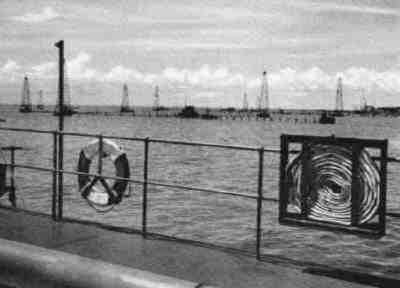
Arriving in Lake Maracaibo and all the oil wells out in the
middle of the lake is a very interesting site.
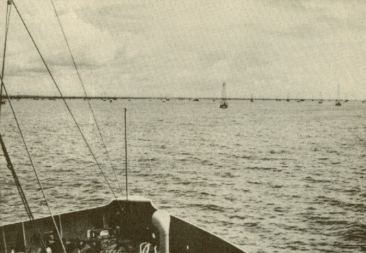
|
|
To find out more about the Lake Tankers and Lago Shipping and some
wonderful photos of the old tankers, go to Auke
Visser's web site:
http://www.aukevisser.nl/ |
| The following information about Lake Tankers is
taken from Dan Jensen's short history of Lago refinery.
CLICK ON THIS LINE TO GO TO THAT STORY |
|
The
Lake Tankers, The Supply Line to the Lago Refinery |
|
The entire operation in
Aruba depended on a fleet of little tankers that carried the crude from
Lake Maracaibo, through the shallow cannel to Aruba. Now is a good time to go into a little about the lake tanker
fleet that served the Aruba refinery. |
|
The operation of the lake tankers
(a lake tanker was a small vessel of about 6,000 tons) was critical to
the operation of the Aruba refinery and although ownership of the
tankers changed during the period they always operated to supply the
Aruba refinery until after World War II. |
|
These lake tankers must have been
well built, two of them, the Inverrosa and the Inverruba
were reassigned to act as fuel oilers off the coast of West Africa, they
served for four years without going to dry-dock or undergoing major repairs.
Three of the lake tankers, because of their shallow draft and flat
bottoms, were converted into tank landing ships (LST’s); they were the Bachaquero,
Misoa and the Tusajera. |
|
The German High Command,
realizing the importance of the refineries in Aruba and Curaçao,
sent a task force of U-boats to disrupt the shipments of crude to these
refineries. In this attack on the
night of February 16, 1942 four lake tankers, the Pedernalas, Oranjestad,
Tia Juana, and the San Nicholas, were torpedoed and three sank and
the forth, the Pedernalas, was beached with her mid-section, (the
bridge and ships steering), destroyed. She
was taken to the dry dock at Lago, the mid section was removed and the fore
and aft section welded together, a temporary wheel house was added at the
dry-dock in Aruba and she made it to Baltimore under her own power, where a
new amidships section was added. These
four lake tankers had a total crew of 102 and of those, 47 lost their lives. This attack put a great strain on the remainder lake tankers
to supply crude to the Aruba refinery. |
|
Before the attack the lake tankers
were not protected, after the attack operations were restricted to
daylight hours and naval destroyers escorted the tankers.
This practice lengthened the turnaround time from 2.58 days to 4 days.
The loss of the four-torpedoed tankers cut the amount of crude carried
to Aruba by 115,700 barrels per day. This
was another contributing factor to the loss of production at the Aruba
refinery in 1941. |
|
This loss of production
prompted the Maritime Commission to approve the construction of seven
new lake tankers under wartime conditions, using materials that were in
short supply. |
|
The contract for these seven lake
tankers was signed on April 30, 1942.
The contract was for a shallow-draft, twin-screw, steam-powered tanker
of the Boscan class. These
tankers were designed to have a capacity of 5,650 tons and a speed of about 10
knots. The contract to build these new ships was signed with the Barnes-Duluth
Shipbuilding Company of Duluth, Minnesota.
The first tanker was delivered on July 1, 1943 and the seventh tanker
was delivered on in October 1943. The
San Joaquin was delivered on August 27, 1943, the Caripito on
September 10, 1942, Temblador on September 20, 1943, San Cristobal
on September 28, 1943, Guiria on October 21, 1943, Guarico on
October 28, 1943 and Valera on November 8, 1943. The Valera was torpedoed on March 7, 1944 off the
coast of Barranquilla, Columbia while carrying a cargo of fuel oil from Aruba
to the Panama Canal. All of the
crew and officers, except for the Captain, escaped the burning, sinking ship
and were rescued. |
|
To get these new lake tankers to
Aruba they were sailed from Duluth, Minnesota, through Lake Superior,
the St. Mary's River, Soo Locks, the northern section of Lake
Huron, Mackinac Straits, the entire length of Lake Michigan to Chicago,
through the Chicago Sanitary and Ship Cannel, the Des Plaines River, the
Illinois River and into the Mississippi and down to New Orleans.
The trip had to be made in daylight hours, as there were no night
navigational aids on the rivers at the time.
It was a distance of 2,247 miles and one tanker took 28 days and the
shortest time to make the trip was 15 days. |
|
In New Orleans the tankers were
again dry-docked, defense equipment was installed, (presumably deck
guns) the wheelhouse and mast were added and the bottom was again
painted before going on to Aruba. Because
of low bridges encountered on the trip the ships could not have a height in
excess of 53' 6". Therefore,
they left the Duluth shipyard without a wheelhouse cover, superstructure or
masts. |
|
|
In the early 1950's new ports were built in Venezuela from which to ship
crude, the entrance to Lake Maracaibo was dredged deeper and this
allowed larger tankers to carry crude to the refineries in Curaçao and
Aruba and thus the Lake Tankers were phased out of service. This
is the story of the Invercaibo and her retirement. |
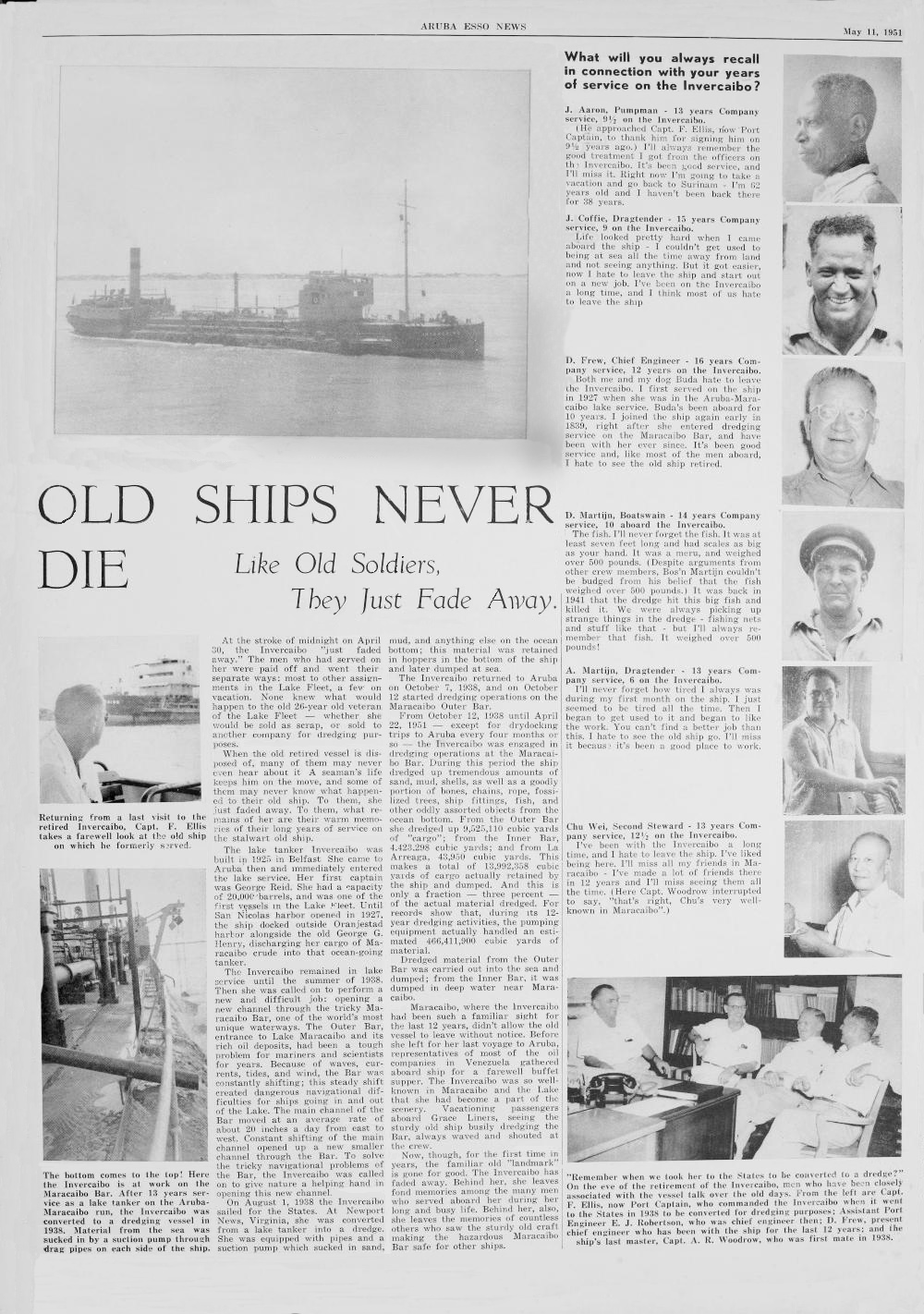 |
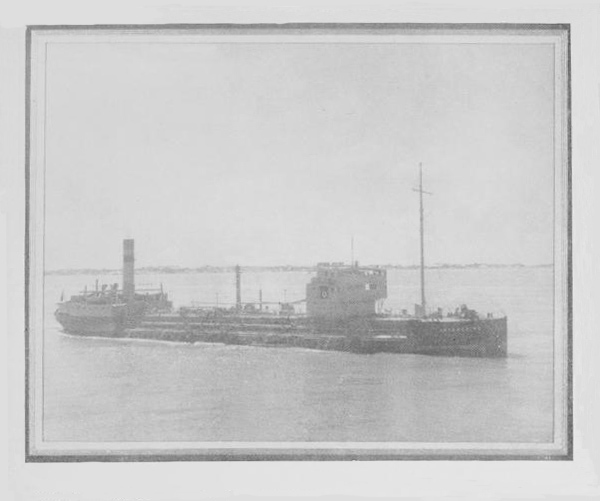 |
|
|
On December 10, 1954
the Lake Tanker "Trujillo" became the last Lake Tanker to be phased out of
the fleet and the Lake Tanker fleet was no more. |
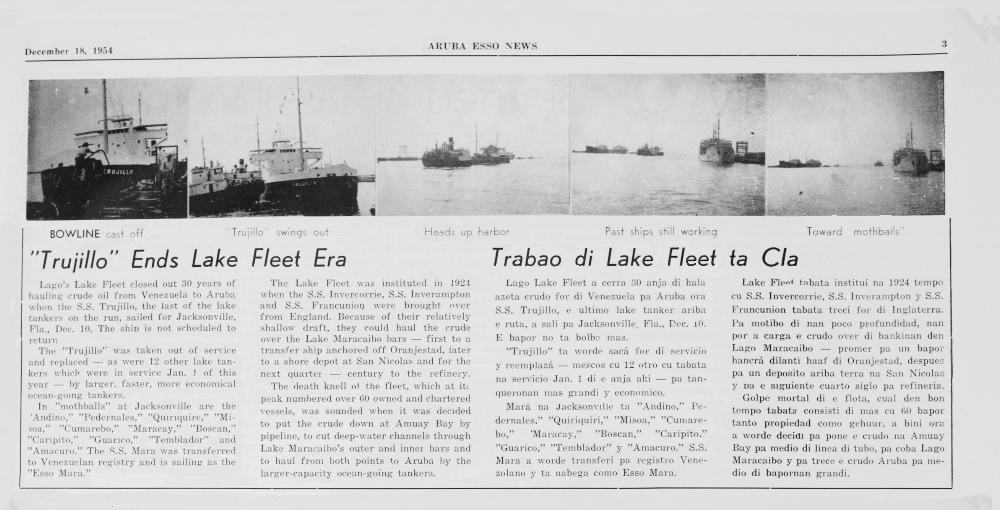 |
|
|
The Lake Tankers were replaced by the ships show below. |
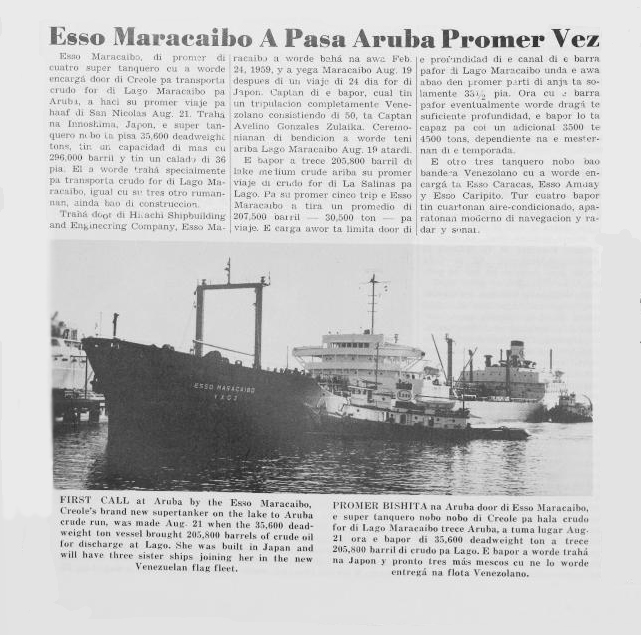
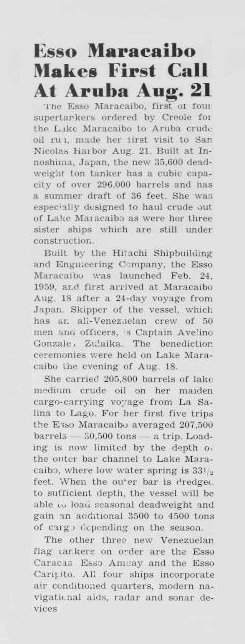 |
|
These ships were registered in Venezuela and were manned by an all
Venezuelan crew. |
|
|
|
RETURN TO LAGO REFINERY
DIRECTORY |
|
GO TO THE LAGO DRY DOCK
PAGE |
|
CLICK HERE TO
READ ABOUT LIFE ABOARD A LAKE TANKER |
|
CLICK HERE SEE
GOING ON A TRIP ON A LAKE TANKERS |
|
CLICK HERE TO
READ ABOUT LAKE TANKER FAMILIES |







 Picture
on the right, a view from the Bridge of the Esso Trujillo looking aft to
the back of the Lake Tanker.
Picture
on the right, a view from the Bridge of the Esso Trujillo looking aft to
the back of the Lake Tanker.






